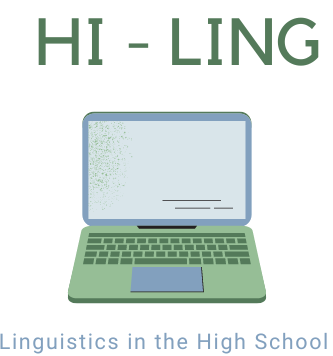HI-LING
LINGUISTICS IN THE HIGH SCHOOL

UNIT 2: VIOLATION OF MAXIMS
Introduction to Semantics
What do we mean when we talk about Semantics? Why is it important?

What is language?
Every person speaks a language, no matter where or when they are born and grow up. Each language is different, some more related, others less. Yet they all consist of more or less the same building blocks and function in roughly similar ways.
Exercise 1
What kinds of building blocks and concepts make up languages? Discuss alone or with a partner.
In the field of linguistics, the "correct" answer depends on what specialisation you are focusing on. One field that concerns itself with such questions is called semiotics.
What is semiotics?
Semiotics is the so-called study of signs and symbols, a central point of all linguistics. However, we are not talking about a visual sign, such as a road signs, as you might be thinking of right now, but rather about the connection between a word and its meaning(s). We can use all kinds of signs to communicate and convey our thoughts.
Saussure, a Swiss language expert born in Geneva, established the semiotics sign-system:
There is the "signifier", the physical form a sign takes. It can be an image, a sound, letters, spoken or written words or gestures. The idea that comes to our mind, the mental concept, is the "signified".
The signifier and signified work like two sides of a coin and together they make up a sign.
For example, when we read the word “tree”, we think about something that grows out of the ground, is tall and has green leaves and a brown trunk. Therefore, the word (signifier) and concept (signified) are connected because we cannot have one without the other.
The same is happening when you see the letter “M” or “McDonald's”; you know it is a place to eat burgers and McFlurry. When you see “pull” or "push" on a door, you know whether to pull the door towards you or push it.
We learn the meanings of these words in school and at home. Often, we do not think about the science behind it. We take it for granted because it happens automatically.
It is important to keep in mind that the signifier and the signified are not the same. For example, when we read the word “open” in front of a shop, the word means that the shop is “ready for business”. However, when we read the word “open” on or near a button by a lift, it means “open the doors for people to enter/exit the lift”.
Thus, we can have the same signifier (here the word “open”) connected with a different signified, be that in the context of an open shop or to open the doors of a lift. Both are very similar but not the same.
a) Think about why the colour red means “stop” and green means “go” at traffic lights. Or why “thumbs up” means agreement and “thumbs down” means disagreement. Why are girls linked with pink, and boys with blue? How do these things become well-known and understood?
b) Find more cases where the signifier stays the same but the signified changes and/ or the signified stays the same but the signifier changes.
Response:
a)
b)
Exercise 2
Semantics is the study of meaning. It looks at how words convey messages and ideas as well as how they are related to our personal beliefs and the cultures. This can sometimes make it tricky to find common meanings that everyone agrees on and that work in all situations. However, many times our understandings of words overlap which helps us communicate.
English has over 500’000 words, but even well-read people know only around 50’000 of them. So, we often come across new words. To communicate we have to expand our vocabulary and need to learn not just the words but also what they mean.
Meanings can also change over time. If you compare a text by Shakespeare to something written today, you will notice that Shakespeare's words can be tough to read because the slang back then was different from what we use now.
In short, meaning is messy and dynamic. To make sense of it, some linguists have closely studied meaning and come up with ways to categorise and explain how we create meaning from infancy onward. One way to look at meaning is through the analysis of semantic features, asking the question of what kind of features make a word or the meaning of a word distinct from each other.
What is semantics?
Exercise 3
a) Semantic matrix: fill out with “+” if the feature matches the dishes, and a “-” if not.
b) Discuss with your neighbour which ones you did not know. Can you add a few more dishes from all over the world?

